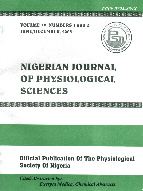
|
Nigerian Journal of Physiological Sciences
Physiological Society of Nigeria
ISSN: 0794-859X
Vol. 30, No. 1, 2015, pp. 111-118
|
 Bioline Code: np15016
Bioline Code: np15016
Full paper language: English
Document type: Research Article
Document available free of charge
|
|
|
Nigerian Journal of Physiological Sciences, Vol. 30, No. 1, 2015, pp. 111-118
| en |
Baseline Haematology and Erythrocyte Morphological Changes of Apparently Normal Dogs Raised in Ibadan, Oyo State
Adekola, A.A.; Jagun, A.T.; Emikpe, B.O. & Antia, R.E.
Abstract
This study evaluates the haematological parameters and the observed erythrocytes morphological changes
in dogs raised in Ibadan, Oyo State in the south western part of Nigeria. Blood samples were collected from sixty-four apparently healthy dogs. The haematological parameters of the blood samples collected were evaluated with the quantification of the percentage erythrocyte morphological abnormalities. The result of the quantitative count of the erythrocyte morphological abnormalities were also converted using reference guide to give the numerical/descriptive clinical grade of the associated morphological abnormalities. There was a significant difference between the haematological parameters reported in this study and the commonly used dog haematological reference ranges from temperate regions used in laboratories in Nigeria. Some of the morphological abnormalities observed in this study include echinocyte (4.12±0.35%), macrocyte (2.61±0.22%) and spherocyte (2.17±0.29%) and eccentrocyte (0.39±0.06%) while other such as acanthocyte (1.39±0.19), leptocyte (0.71±0.13), schizocyte (0.703±0.104) and codocyte (0.50±0.11) were also seen. These study findings show that the associated morphological changes were all not significant and fall within the acceptable range using the reference guide for erythrocyte morphological abnormalities even when the haematological values differ significantly from
the reference value. This study provides baseline information on the haematological parameters and the novel correlation of
the associated erythrocyte abnormalities seen as a corresponding proof of the apparently healthy status of the dogs raised in Ibadan used for this study. The study while serving as an important means of verification of the reference range of haematological parameters also shows that clinical case interpretation using haematological baseline data from the temperate region should be used with caution in our tropical environment. This thus necessitates the need for an advocacy to build a reference range of haematological parameters that can be used as a working baseline value for the tropical environment.
Keywords
Haematological parameters; Erythrocyte morphological changes; South Western Nigeria
|
| |
© Copyright 2015 - Nigerian Journal of Physiological Sciences
|
|
